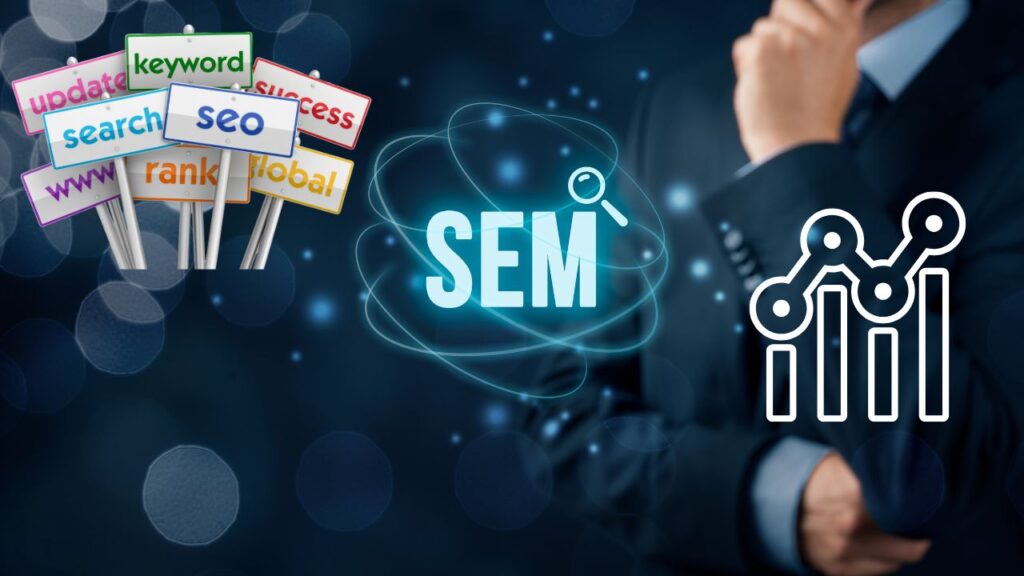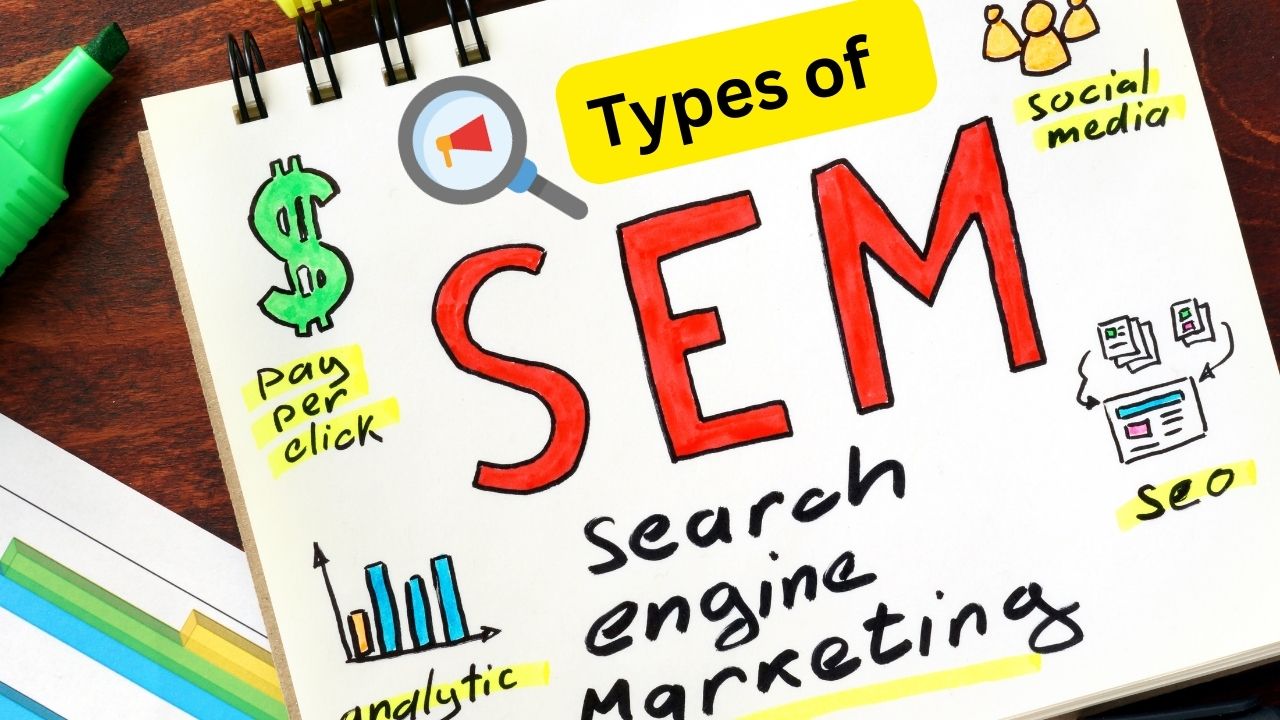Understanding SEM: What It Is and Why It Matters
What Is SEM And Types In the digital world, businesses strive to enhance their online visibility, and one effective approach is through search engine marketing (SEM). But what is SEM, and why does it matter to you as a business owner or marketer? Let’s dive into the concept and explore its significance.
Search Engine Marketing is a form of online advertising that aims to increase the visibility of websites on search engine results pages (SERPs). Unlike standard methods of marketing or organic search, SEM focuses on paid advertising strategies. This means that businesses can bid for their ads to appear prominently whenever users search for specific terms or keywords. SEM not only assists in reaching a wider audience but also heightens brand awareness.

Understanding the Key Components of SEM
What sets SEM apart is its reliance on various essential elements. Let’s look at some of these components:
- Paid Search Ads: These are ads that appear at the top of search results and are labeled as ads. They are a direct way to attract potential customers.
- Keyword Research: Identifying the right keywords is crucial. Businesses must determine what terms their target audiences are searching for to tailor their content and ads accordingly.
- Bidding Strategies: SEM involves bidding on keywords. You set a maximum amount you’re willing to pay for each click. The goal is to find a balance between cost and visibility.
- Ad Campaigns: Organizing your ads into campaigns helps in managing and analyzing performance more effectively.
- Analytics and Tracking: Monitoring results allows businesses to adjust their strategies based on performance and return on investment.
The Types of SEM Strategies
SEM encompasses various strategies that businesses can implement. Here are the primary types:
| Type | Description |
|---|---|
| Search Ads | Ads displayed on search engine results page after a user searches for specific keywords. |
| Display Ads | Banners or visual ads shown on websites or apps within Google Display Network. |
| Shopping Ads | Product-based ads, usually including images and prices, seen when users search for specific products. |
| Video Ads | Ads that play before, during, or after videos. Often seen on platforms like YouTube. |
| Remarketing Ads | Ads targeted at users who have previously interacted with your website or app, encouraging them to return. |
Why SEM Is Important
Understanding the significance of SEM can transform your approach to online marketing. Here are a few reasons why SEM is crucial:
- Quick Results: Unlike organic search, which can take time to build, SEM delivers immediate visibility and traffic to your website.
- Highly Targeted: You can target your ads based on demographics, locations, and user behavior. This laser-focus enhances conversion rates.
- Brand Awareness: Even if users don’t click on your ads, they’re more likely to remember your brand due to increased visibility.
- Measurable Results: With detailed analytics, you can see what’s working and what isn’t, allowing for timely adjustments to maximize ROI.
SEM is not just an option; it’s a powerful tool in the digital marketing arsenal. By understanding what SEM is and the types available, you’re one step closer to leveraging its potential to help your business thrive in a competitive landscape. By actively engaging in SEM, businesses can efficiently connect with their desired audience, creating opportunities for growth and success.
The Differences Between SEM and SEO
What Is SEM And Types when navigating the world of online marketing, understanding the distinctions between SEM and SEO is crucial for your success. These two strategies play significant roles in attracting visitors to your website, but they operate in different ways. Let’s delve into their differences to help you make informed decisions for your digital strategy.
What is SEM?
Search Engine Marketing, or SEM, is a broader concept that encompasses various strategies to promote websites by increasing their visibility in search engine results pages (SERPs). It primarily focuses on paid advertising methods, enabling businesses to reach a wider audience quickly. Through SEM, you can bid on keywords relevant to your business, allowing your ads to appear on search engines like Google and Bing.
What is SEO?
Search Engine Optimization (SEO) is the practice of enhancing your website to improve its organic visibility in search results. Unlike SEM, SEO focuses on optimizing your site to rank higher without paying for placement. It relies on both on-page and off-page techniques, including keyword research, content creation, link building, and ensuring a good user experience.
Key Differences
To help you grasp the distinctions, here’s a comparison of SEM and SEO:
| Factor | SEM | SEO |
|---|---|---|
| Definition | Paid search advertising | Organic search optimization |
| Cost | Requires budget for ads | No direct cost for organic traffic |
| Speed of Results | Immediate visibility | Takes time to see results |
| Click-through Rates | Often lower than organic | Generally higher click-through rates |
| Long-term Strategy | Short-term campaigns | Long-term investment |
Benefits of SEM
Implementing SEM has several advantages:
- Targeted Reach: SEM allows you to target specific demographics by selecting keywords that match your audience’s intent.
- Control Over Budget: You can adjust your spending to fit your marketing budget, making it a flexible option.
- Measurable Results: You can track the performance of your ads in real time, helping you to refine your campaigns.
Benefits of SEO
On the other hand, SEO offers its unique set of benefits:
- Cost-Effective: Once optimized, your content continues to draw traffic without the ongoing cost of ads.
- Credibility and Trust: Organic search results often build a greater sense of trust among users compared to paid ads.
- Longevity: A well-optimized website can continue to attract visitors long after the initial efforts are made.
Choosing the Right Strategy
What Is SEM And Types the choice between SEM and SEO depends on several factors, including your budget, goals, and timeline. If you need immediate results and have the budget, SEM might be the right choice for you. However, if you’re looking at long-term growth and sustainability, integrating SEO into your plan can yield substantial results.
Ultimately, many businesses find that a combination of both SEM and SEO offers the best approach to gaining traction in search engine results. By understanding the differences between these two powerful strategies, you can better tailor your digital marketing efforts to meet your specific needs.
Key Components of a Successful SEM Campaign
Launching a successful SEM campaign requires careful planning and execution. Several key components play a vital role in achieving your advertising goals. Understanding these elements is crucial for maximizing your online visibility and return on investment.
Keyword Research
Effective keyword research is the foundation of any SEM campaign. It involves identifying the terms and phrases that potential customers use when searching for products or services like yours. Here are essential points to consider:
- Relevance: Focus on keywords that align closely with your offerings.
- Search Volume: Choose keywords with a substantial number of searches to ensure a wider audience.
- Competition: Analyze how many businesses are bidding on these keywords; low competition can often yield better results.
Creating Compelling Ads
Your ad copy must capture attention and generate clicks. High-quality ads encourage users to learn more about what you offer. Here are tips for crafting effective ads:
- Clear and Concise Language: Use straightforward language that describes your product or service effectively.
- Strong Call to Action (CTA): Encourage users to take action with phrases like “Shop Now” or “Learn More.”
- Value Proposition: Highlight what makes your offering unique or beneficial.
Landing Page Optimization
Your landing page is where users arrive after clicking your ad. It should be optimized for conversions. Key elements include:
- Relevance: Ensure the landing page content reflects the ad while addressing user intent.
- Loading Speed: A fast-loading page enhances user experience and reduces bounce rates.
- Mobile Responsiveness: Optimize for mobile since many users browse and shop through their phones.
Bidding Strategies
The bidding strategy you choose impacts how often your ads show up in search results. Common approaches include:
- Cost-Per-Click (CPC): You pay only when someone clicks your ad, making it a popular choice for many businesses.
- Cost-Per-Thousand Impressions (CPM): This strategy focuses on ad visibility, charging for every 1,000 views.
- Target CPA (Cost-Per-Acquisition): Set a target cost for acquiring new customers, which helps align your budget with conversions.
Ad Tracking and Analytics
Monitoring your campaign’s performance is essential for ongoing improvements. Key metrics to track include:
- Click-Through Rate (CTR): This indicates how effective your ads are in generating clicks.
- Conversion Rate: Measure the percentage of visitors who complete a desired action.
- Return on Ad Spend (ROAS): Assess how much revenue is generated for every dollar spent on advertising.

Testing and Optimization
Continuous testing helps refine your campaign for optimal performance. This can involve:
- A/B Testing: Compare different ads or landing pages to see which performs best.
- Adjusting Keywords: Regularly review and update your targeted keywords based on performance.
- Improving Ad Copy: Revise ad text based on engagement data to increase click rates.
Understanding Target Audience
Identifying your target audience helps tailor your messaging and ads effectively. Key factors to consider include:
- Demographics: Age, gender, location, and interests can significantly influence ad performance.
- Behavior: Analyze user behavior to understand how potential customers interact with your site.
- Device Usage: Knowing whether your audience primarily uses mobile or desktop can guide your ad formats.
What Is SEM And Types, A successful SEM campaign hinges on these core components. By utilizing effective keyword research, crafting compelling ads, optimizing landing pages, and monitoring performance stats, you can navigate the complexities of search engine marketing. Implementing these strategies increases your chances of achieving objectives and reaching the right audience with the right message.
Exploring Different Types of SEM Strategies
Search Engine Marketing (SEM) is a crucial component of digital marketing that helps businesses reach their goals effectively. This strategy primarily involves the promotion of websites through paid advertising on search engines. By understanding the different types of SEM strategies available, you can enhance your online presence and drive targeted traffic to your site. Let’s explore these various SEM strategies.
Types of SEM Strategies
What Is SEM And Types there are several types of SEM strategies that businesses can utilize to maximize their online visibility. Understanding these strategies will enable you to choose the best approach for your marketing needs. Below are key types of SEM strategies:
- Pay-Per-Click (PPC) Advertising
- Immediate visibility on search engines
- High ROI when campaigns are optimized
- Detailed analytics to measure campaign performance
- Display Ads
- Brand awareness through eye-catching visuals
- Retargeting options to reach past website visitors
- Flexibility in ad placement and design
- Remarketing
- Increased brand recall
- Higher conversion rates since users are already familiar with your brand
- Customizable ads based on user behavior
- Search Engine Optimization (SEO)
- Cost-effective long-term visibility
- Enhanced credibility and trust among users
- Consistent traffic without ongoing ad spend
Comparison of SEM Strategies
To better understand how various SEM strategies stack up against each other, consider the following table:
| Strategy | Cost | Time to Results | Targeting | Traffic Type |
|---|---|---|---|---|
| PPC Advertising | Cost-per-click | Immediate | Highly targeted | Paid traffic |
| Display Ads | Cost-per-impression or click | Moderate | Demographic and behavioral | Paid traffic |
| Remarketing | Cost-per-click or impression | Moderate | Specific user behavior | Paid traffic |
| SEO | No direct cost (content creation costs apply) | Long-term | Keyword-based | Organic traffic |
Choosing the Right SEM Strategy
When selecting an SEM strategy, consider the following factors:
- Your Budget: Determine how much you are willing to spend on advertising versus organic efforts.
- Your Timeline: If you need immediate results, PPC or display ads may be more suitable.
- Your Goals: Define what you want to achieve, whether it’s brand awareness, lead generation, or direct sales.
Exploring different types of SEM strategies provides valuable insights that can help you tailor your marketing campaigns to meet your specific needs. Implementing the right approach will ultimately lead to better engagement and higher conversion rates for your business.
Measuring the Success of Your SEM Efforts
What Is SEM And Types, Measuring the success of your SEM (Search Engine Marketing) efforts is crucial to optimizing your campaigns and ensuring a positive return on investment (ROI). Understanding what metrics to track can help you adjust your strategies and allocate your resources more effectively. Here’s how you can measure the impact of your SEM activities.
Key Metrics to Monitor
The following are essential metrics to consider when evaluating your SEM performance:
- Click-Through Rate (CTR): This metric indicates how often people click on your ad after seeing it. A higher CTR suggests that your ad is relevant and engaging to your target audience.
- Conversion Rate: This shows the percentage of users who take a desired action after clicking on your ad, such as making a purchase or signing up for a newsletter. Higher conversion rates indicate effective SEM strategies.
- Cost Per Click (CPC): This measures how much you pay each time someone clicks on your ad. Keeping CPC under control is vital for maximizing ROI.
- Quality Score: Google assigns a Quality Score based on the relevance of your ad, keyword, and landing page. A higher score can lower your CPC and improve ad placement.
- Impressions: This tracks how often your ad is displayed. More impressions can increase brand visibility, but ensure they convert into clicks.
Analyzing Return on Investment (ROI)
Effective SEM isn’t just about getting clicks; it’s about generating profit. To calculate ROI, use the following formula:
| Formula | Description |
|---|---|
| ROI = (Net Profit / Cost of Investment) x 100 | This formula helps you determine how much profit you’ve generated compared to what you spent on your SEM campaign. |
A positive ROI indicates that your SEM efforts are yielding profitable outcomes. If the ROI is negative, it’s time to reassess your strategies.
Tracking Tools and Techniques
Implementing the right tools can make a significant difference in tracking your SEM performance. Consider these options:
- Google Analytics: This free tool offers insights into user behavior on your website. You can track traffic sources, conversions, and user engagement, giving you a comprehensive view of your SEM impact.
- Google Ads Performance Reports: Access in-depth reports from your Google Ads account to gauge how your campaigns are performing in real-time. These reports include metrics like CTR, CPC, and conversion data.
- A/B Testing: Conduct tests comparing different versions of your ads or landing pages. This helps you understand which elements are most effective and should be used to improve results.
Setting Goals and Benchmarks
Establish clear objectives for your SEM campaigns. Knowing what you aim to achieve helps you measure success accurately. Set SMART goals:
- Specific: Define your objective clearly.
- Measurable: Ensure you can track progress towards your goal.
- Achievable: Set realistic expectations.
- Relevant: Align your goals with broader business objectives.
- Time-bound: Assign a timeframe for achieving your goals.
Adjustment and Optimization
Tracking and analyzing SEM success is an ongoing process. Use the data you gather to make informed decisions. Consider these adjustment strategies:
- Keyword Refinement: Regularly update your keyword list based on performance. Utilize negative keywords to filter out irrelevant traffic.
- Ad Copy Testing: Regularly refresh your ad contents based on performance metrics. Test different headlines and calls-to-action to find what resonates with your audience.
- Landing Page Optimization: Ensure your landing pages are relevant to your ads and provide a seamless user experience. A well-designed landing page can significantly improve conversion rates.
What Is SEM And Types, Measuring the success of your SEM efforts requires careful attention to various metrics, a solid understanding of ROI, and the ability to adapt strategies in real-time. By employing the right tools and approaches, you can maximize the effectiveness of your SEM campaigns and drive better results for your business.

Key Takeaway:
Key Takeaway: Navigating the Landscape of Search Engine Marketing (SEM)
What Is SEM And Types, Search Engine Marketing (SEM) is a vital component of digital marketing that focuses on promoting websites by increasing their visibility in search engine results pages (SERPs) through paid advertising. Understanding SEM is essential for businesses looking to enhance their online presence and reach potential customers effectively. Unlike Search Engine Optimization (SEO), which relies on organic methods to improve rankings, SEM combines paid strategies like pay-per-click (PPC) advertising, enabling businesses to gain immediate visibility.
To craft a successful SEM campaign, several key components are necessary. First, you need to define your audience; knowing who your potential customers are helps tailor your ads to their preferences. Second, selecting the right keywords is crucial. Researching keywords that resonate with your audience and analyzing competitors’ keyword strategies can significantly impact your campaign’s success. Next, creating compelling ad copy and eye-catching visuals ensures that your ads stand out and attract clicks.
Diving deeper into SEM strategies, various approaches can be implemented, such as keyword targeting, display advertising, and video advertising. Each type serves different purposes – keyword targeting aims to capture search intent, while display and video ads build brand awareness. A diversified strategy helps businesses connect with audiences at various stages of the buying journey.
Measuring the success of your SEM efforts is vital to understanding what works and what doesn’t. Tracking key performance indicators (KPIs) such as click-through rates (CTR), conversion rates, and return on ad spend (ROAS) helps you assess the effectiveness of your campaigns. Regular analysis allows for continuous optimization, refining your strategies to achieve the best possible outcomes.
Mastering SEM is vital for any business that wants to succeed in today’s digital landscape. By understanding its differences from SEO, implementing essential components, exploring varied strategies, and measuring results, you can drive targeted traffic to your site, increase conversions, and ultimately boost revenue. Investing time and effort into SEM can yield significant returns and solidify your brand’s online presence.
How to Optimise SEM Ads – The 7 Best Things to know in 2025 Click here to learn more .
Conclusion
What Is SEM And Types, as we delve into the world of Search Engine Marketing (SEM), it’s clear that this powerful tool plays a crucial role in the digital marketing landscape. Understanding SEM and its significance allows businesses to effectively reach their target audiences while boosting online visibility. By recognizing the differences between SEM and SEO, marketers can strategically allocate resources and tailor their efforts for maximum impact.
A successful SEM campaign is built on several key components, including keyword research, compelling ad creatives, and the use of targeted landing pages. These elements work together to attract potential customers and drive conversions. By exploring various SEM strategies such as pay-per-click (PPC) advertising, remarketing, and ad extensions, businesses can find the approach that best aligns with their goals.
Measuring the success of SEM efforts is vital for continuous improvement and optimization. Key performance indicators (KPIs) such as click-through rates, conversion rates, and return on ad spend provide valuable insights into campaign performance. By analyzing these metrics, marketers can refine their strategies, ensuring that their SEM initiatives remain effective and competitive.
Ultimately, embracing SEM and its diverse strategies is essential for any business looking to thrive in today’s digital marketplace. By committing to ongoing learning and adaptation, companies can harness the full potential of SEM, leading to increased visibility, engagement, and growth.
FAQ
What is SEM and its types
Search Engine Marketing (SEM) is a digital marketing strategy used to increase website visibility in search engine results pages 1 (SERPs) through paid advertising. SEM helps businesses attract more targeted traffic to their websites by bidding on relevant keywords. There are two primary types of SEM: Pay-Per-Click (PPC) advertising and Pay-Per-Impression (PPM) advertising.
What are the two types of search engine marketing?
The two primary types of search engine marketing are Search Engine Optimization (SEO) and Pay-Per-Click (PPC) advertising. SEO focuses on optimizing your website’s content and structure to improve organic search rankings, while PPC involves bidding on keywords to display ads on search engine results pages.
What is the role of SEM
Search Engine Marketing (SEM) plays a crucial role in boosting a website’s online visibility. It involves paid advertising strategies to increase website traffic and improve search engine rankings. By targeting specific keywords, businesses can reach their desired audience and drive conversions effectively.
Is Google Ads a SEM
Yes, Google Ads is a prominent platform for SEM (Search Engine Marketing). It allows you to create and manage paid advertising campaigns on Google Search and other platforms. By bidding on relevant keywords, you can display your ads to potential customers searching for your products or services.
When to use SEM?
Consider using SEM when you want to quickly drive traffic to your website, launch a new product or service, or boost sales during a specific campaign. SEM allows you to target a specific audience and measure your return on investment (ROI) in real-time.

